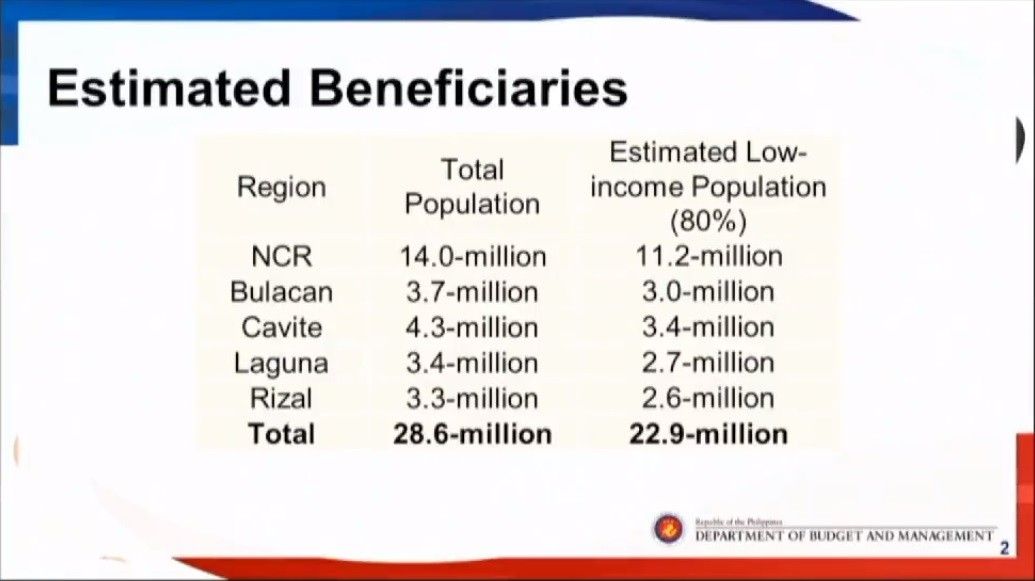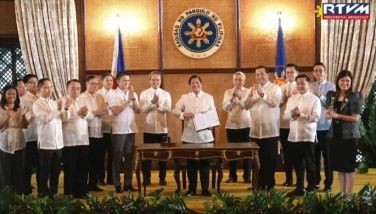What we know so far: Aid for areas under ECQ 2.0

MANILA, Philippines (Update 1, March 20, 2021 9:54 a.m.) — To complete the Philippines’ ongoing throwback to its pandemic response last year, the government is rolling out assistance to poor families trapped under enhanced community quarantine (ECQ). But they won’t get the aid until mid-April, at the very least.
Who will benefit?
On Monday, Budget Secretary Wendel Avisado told reporters 22.9 million poor Filipinos in Metro Manila, Bulacan, Cavite, Rizal and Laguna are set to get the aid. The number represents 80% of the low-income population in the area as estimated by the National Economic and Development Authority.
The Philippines does have an experience on distributing aid like the P200-billion social amelioration program (SAP) last year that benefited 13.96 million households of at least 5 people, the list to which, President Rodrigo Duterte said, will be used as basis for the latest round of assistance.

Why is there an assistance?
Under old rules, the government is expected to extend aid to people whenever an ECQ is enforced. This is because under an ECQ, some businesses are not allowed to operate to lessen people on going around, and thereby prevent the spread of infections. In turn, while some of their employees may use their leaves to get paid while ECQ is in effect, some people will still be out of work, and therefore not earning. This is where government assistance should come in to moderate their hardships.
How much is the aid?
Avisado said each poor resident will receive aid amounting to P1,000, which local government units may give either "in kind or in cash" once the funds are downloaded to them. The amount will not exceed P4,000 per family.
As it is, the aid to be extended this time is much smaller than the amount under the Bayanihan to Heal As One Act or Bayanihan I — the old law that served as basis for the P200-billion SAP last year that gave out between P5,000 and P8,000 per household, depending on regional location.
When and where will the aid be available?
Presidential spokesperson Harry Roque, quoting Finance Secretary Carlos Dominguez III, said the government is targeting the full release of aid by “mid-April.” But that does not necessarily mean that beneficiaries will get the aid by then. That only means that funds for that purpose are released from state coffers to city and municipal governments which, in turn, should reach out to poor households.
That said, the government has a very bad record on giving out aid. Last year’s cash subsidy given by the social welfare department took over 6 months to get completed. The difference this time however is the covered areas and the amounts involved are smaller, so that may accelerate the process. At the same time, local government units that have better grassroots connections will be in charge of the job.
Will I get the aid even if ECQ is already over?
Supposedly, the enhanced community quarantine (ECQ) prevailing over the capital region and four nearby areas will only last until April 4. But Alethea de Guzman, director of the health department’s epidemiology bureau, said on Monday that the agency has crafted COVID-19 case scenarios where an ECQ would be in effect until April 18. Roque said this is yet to be discussed. Either way, aid will continuously be distributed even after the ECQ is lifted.
Will there be more assistance after this?
No, Avisado said the government’s assistance to poor ECQ dwellers will only be for “one time.”
Where will government source funds for the assistance?
Avisado said the budget department has identified unreleased funds from the Bayanihan to Recover As One Act, the second pandemic package passed last September 2020. That law mandated P140 billion in additional spending for aid, as well as capital for state banks to lend out interest-free loans. Those funds would have expired unused after 2020, but a separate law was passed to extend their validity until June 30, 2021.
Budget Undersecretary Laura Pascua said in a Viber message funds for the latest assistance include cash from “interest payments savings” from last year.
Editor's note: This will be updated as soon as new information is released.
- Latest
- Trending



























 Exclusive
Exclusive